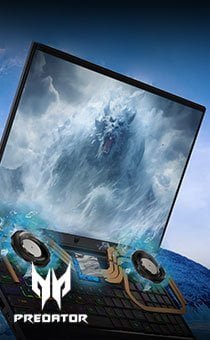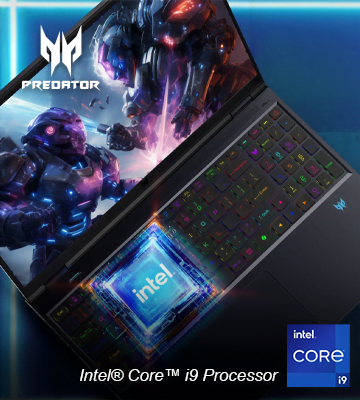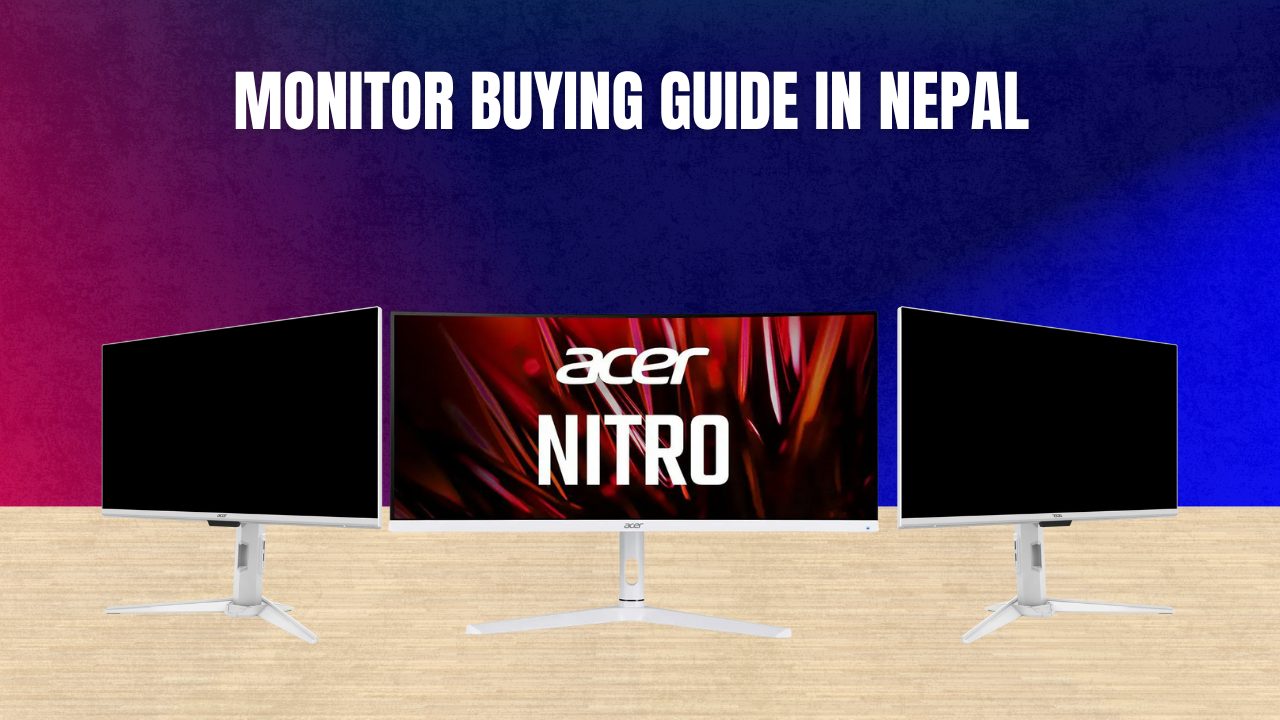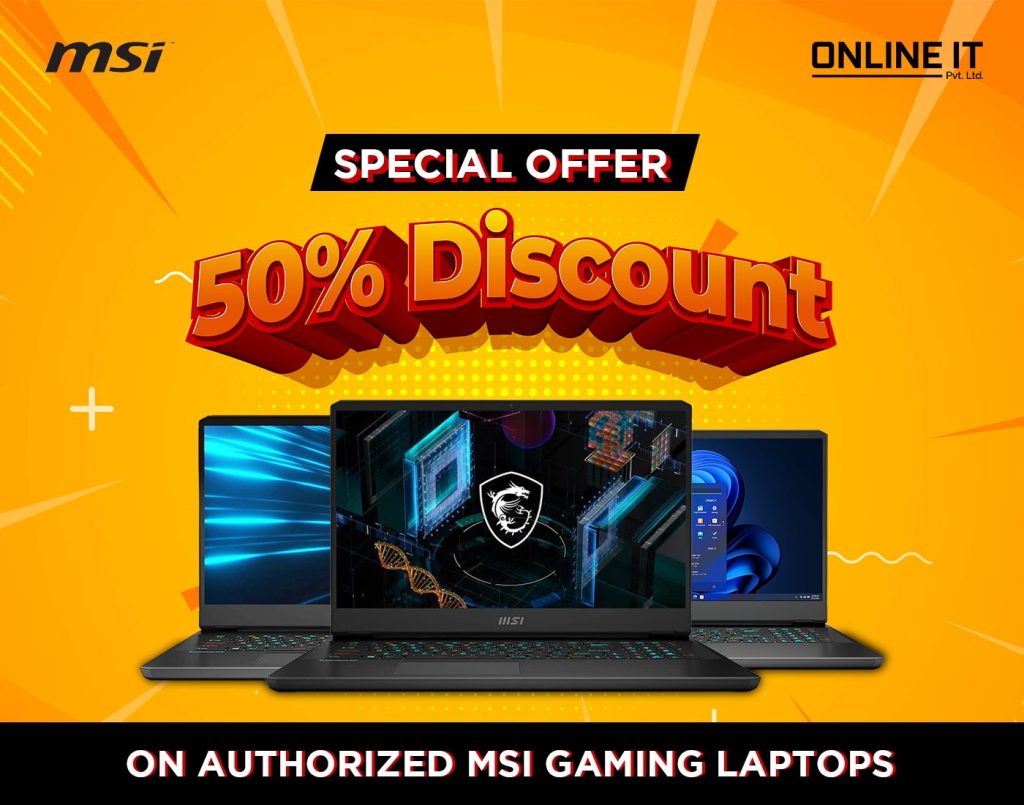Choosing the right monitor is like picking the right screen for your work or play—it should match your needs, fit your space, and show clear visuals. Monitors are no longer just extra screens. They are now an important part of how people work, study, and relax. Whether you are a student attending online classes, a professional handling tasks, or a gamer looking for smooth gameplay, the right monitor will improve your experience.
This monitor buying guide explains the key parts of a monitor and helps you understand how to buy a monitor in Nepal. It also gives you a clear idea of the monitor market in Nepal and shows where to find authorized monitors at the right price.
Quick tip: There are many monitors, each with its size, features, and performance. Before buying, decide how you will use the monitor and how much you want to spend.
1. Understand Your Usage
Before checking screen size, resolution, or other features, first decide how you will use the monitor. Your usage helps define what type of monitor you need, what features matter most, and what price range fits you.
Casual Use:
If you only need a monitor for web browsing, watching videos, or basic tasks like working with documents and spreadsheets, you don’t need to have advanced features. A 22–24-inch Full HD resolution monitor with standard refresh rates and basic color reproduction will work well. These monitors are often the affordable options.
Office or Professional Use:
For programming, data analysis, content writing, or digital marketing, go for a monitor that supports higher resolution and a comfortable screen size. A 24–27-inch QHD monitor helps to reduce your eye strain and improves multitasking with better screen.
Creative Professionals:
Photo editors, video editors, and graphic designers need accurate colors. Look for a monitor with an IPS panel, QHD or 4K resolution, and support for sRGB or AdobeRGB. A 27 to 32-inch screen gives enough space for detailed work and better color control.
Gaming:
For gaming, you need a monitor with a high refresh rate and quick response time. Look for at least 144Hz and a 1–5 ms response time. Features like G-Sync or FreeSync help reduce screen tearing. You’ll also need a good graphics card to keep up with these specs.
Entertainment:
For watching movies or streaming, VA panels with deeper contrast, 27-inch or larger screen sizes, and good viewing angles are ideal. A monitor with built-in speakers may also help reduce desk clutter.
2. Screen Size and Resolution
Screen Size:
Monitor sizes range from 19 inches to 49 inches or more. Larger monitors give more space for multitasking but need more desk space. Here’s a guide:
- 22–24 inches: Suitable for casual and light office tasks.
- 25–27 inches: Best for professionals who work with visuals, multitasking, and content creation.
- 28–32 inches: Great for gamers, editors, and multimedia users.
- Ultra-wide/Curved (34 inches and above): Excellent for immersive experiences and multitasking.
Resolution:
Resolution affects how sharp the display looks. The higher the resolution, the more details you see.
- HD (1366×768): Outdated and not recommended.
- Full HD (1920×1080): Standard resolution for most users.
- QHD (2560×1440): Better clarity, suitable for professionals and gamers.
- 4K UHD (3840×2160): Best for photo/video editing and high-end gaming.
3. Panel Types
The panel type affects color accuracy, viewing angles, and speed.
- IPS (In-Plane Switching): Best color accuracy and wide viewing angles. Suitable for professionals, creatives, and general users.
- TN (Twisted Nematic): Low cost and very fast response times. Popular with competitive gamers, but with poor color and narrow viewing angles.
- VA (Vertical Alignment): Great contrast and deep blacks. Good for movies and general work. Slower response times than TN.
4. HDR (High Dynamic Range)
HDR enhances brightness, contrast, and color. Monitors with HDR show more realistic visuals, making them ideal for watching content or gaming. However, not all HDR is equal.
- HDR10: The most common standard. Provides good enhancement.
- DisplayHDR 400/600/1000: VESA-certified levels showing peak brightness capability. Higher is better.
If you work with HDR content or want a better experience in games and movies, go for a monitor with certified HDR support.
5. Refresh Rate and Response Time
These features are crucial for gamers but can also improve general screen fluidity.
Refresh Rate (Hz): Higher refresh rates give smoother visuals.
- 60Hz: Standard for office or casual use.
- 75Hz to 165Hz: Better motion handling for gaming.
- 240Hz or more: Needed for fast-paced competitive gaming.
Response Time (ms): Measures how quickly pixels switch.
- 1–5ms: Ideal for gaming.
- 6–8ms: Acceptable for office and casual use.
6. Bezel Size
Bezels are the borders around your screen. Thin bezels provide a modern, clean look and are useful for multi-monitor setups. If you plan to place two or more monitors side by side, thin bezels reduce visual interruptions.
7. Connectivity Ports
Check the ports available on the monitor. You need the right ports to connect your devices:
- HDMI: Common and works with most laptops, PCs, and gaming consoles.
- DisplayPort: Preferred for high-resolution and high refresh rate setups.
- USB-C: Offers video, data transfer, and power delivery in one cable.
- Audio Jack: Connect headphones or external speakers.
Having more port options adds flexibility in your workspace.
8. Built-in Speakers
Monitors with built-in speakers help save space and reduce cable clutter. But the sound quality is basic and often lacks clarity and bass. If sound quality is important, use external speakers or headphones.
9. Eye Comfort Features
If you spend long hours in front of a screen, consider these features:
- Flicker-Free Technology: Reduces invisible screen flicker to protect your eyes.
- Low Blue Light Filter: Filters harmful blue light that causes eye strain and fatigue.
- TÜV Rheinland Certification: Verifies safety and comfort standards.
10. Budget and Price in Nepal
Monitor prices in Nepal vary depending on brand, specs, and availability.
- Entry-level Monitors (NPR 14,000–24,000): Good for basic use.
- Mid-range Monitors (NPR 25,000–50,000): Suitable for professionals and gamers.
- High-end Monitors (NPR 60,000 and above): Designed for editing, competitive gaming, or productivity tasks.
Avoid buying gray market products that lack a proper warranty. Always buy from authorized sellers.
Common Monitor Brands Available in Nepal
Dell Monitor: A Reliable brand for business and productivity. Their monitors are known for durability and good build quality. Dell’s UltraSharp series offers excellent color accuracy for professionals.
Acer Monitor: Affordable with strong feature sets. Acer has a range of entry-level to high-end gaming and editing monitors.
MSI Monitor: Best known for gaming monitors with high refresh rates, RGB lighting, and sharp designs. MSI’s Optix series supports adaptive sync and is popular among streamers.
Lenovo Monitor: Offers business-grade monitors with a clean design. They are ideal for office and multitasking use. ThinkVision series balances quality with price.
Other Factors to Consider Before Buying a Monitor in Nepal
Be careful when buying a monitor in Nepal. Many sellers offer different models, but not all are genuine. Some monitors may be refurbished or come through the grey market, which means they are not imported through authorized channels. These products may look new, but they can lack official warranty, service support, or even original parts. Many Reddit users and online forums have reported cases where monitors sold at low prices were found to be used, repaired, or lacking genuine manufacturer support. These posts often mention issues like missing warranties, screen defects, or mismatched serial numbers. Always double-check before buying.
Refurbished and Grey Channel Monitors
Refurbished monitors are used products that have been repaired or repackaged. Grey channel monitors are imported unofficially and may not meet quality standards. These may be cheaper but often come with risks.
Always buy from authorized sellers to get original products with full manufacturer support.
What to Check Before Buying a Monitor
1. Price Comparison
Authorized monitors may cost more, but they include a valid warranty, sealed packaging, and brand support. If a monitor is priced much lower than usual, it could be refurbished, used, or imported without approval. These often lack warranty and may have hidden issues.
2. Packaging
Original monitors come in a sealed, branded box with model details, serial number labels, and brand-authorized packaging. Refurbished or grey market monitors often arrive in plain or reused boxes and may lack accessories like cables, manuals, or stands. Unsealed boxes are a warning sign.
3. Serial Number
Each monitor has a unique serial number printed on the box and the back of the unit. Verify this number on the manufacturer’s website to confirm warranty status, product model, and origin. If the number is missing, altered, or invalid, the product may not be genuine.
4. Warranty
Authorized monitors come with a full manufacturer’s warranty, usually 1 to 3 years, which covers repairs or replacements. Refurbished or unauthorized units may have no warranty or just a short in-store warranty without brand support. Always ask for a warranty card or proof of purchase.
5. Screen and Ports
Before buying, check the screen for dead pixels, uneven brightness, discoloration, or scratches. Also, test all input ports (HDMI, DisplayPort, USB-C, etc.) for proper function. Faulty ports or screen defects are common in refurbished units.
Conclusion
Buying a monitor is a long-term investment, and making the right choice depends on how you use your system, whether for work, gaming, editing, or entertainment. Always match the monitor’s specifications, like resolution, screen size, panel type, and refresh rate, with your specific needs.
Still unsure which monitor suits you best? At Online IT, our experienced professionals will guide you based on your requirements, usage habits, and budget. We offer a wide range of monitors from trusted brands, and we are authorized sellers, ensuring you get genuine products with proper warranty and after-sales service. Avoid unreliable sources. Buy from trusted stores with a warranty.
FAQs
What is the best monitor size for work?
A 24 to 27-inch monitor is ideal for office use. It balances screen space and desk fit, allowing you to multitask easily without eye strain.
Is a 4K monitor necessary for photo or video editing?
Yes, for high-quality editing, a 4K monitor displays more detail and better color accuracy. It helps with precision when editing images or timelines.
How important is refresh rate for non-gamers?
For basic use, 60Hz is fine. A higher refresh rate, like 75Hz, can still make mouse movement and scrolling feel smoother, but it’s not essential.
Are curved monitors worth it?
Curved monitors give an immersive feel and reduce distortion at the edges. They’re great for gaming and productivity, especially ultra-wide ones.
Can I use a TV as a computer monitor?
Yes, but TVs usually have higher input lag and lower refresh rates. A dedicated monitor is better for reading text, working, and fast tasks.
What should I check before buying a second-hand monitor?
Check for dead pixels, discoloration, scratches, port function, and backlight bleeding. Always ask for the original bill and test before buying.




